Blue Roof Best Practice
The changing nature of blue roofs – from simple rainwater storage facilities to state-of-the-art attenuation solutions – has placed this cutting edge building technology at the forefront of current thinking on sustainable drainage systems (SuDS). This shift has been driven in part by changing climate patterns (resulting in more extreme rainfall events), government planning policy, which is encouraging rainwater runoff to be controlled as close to its source as possible, and by increased awareness and information sources, such as the NFRC’s Technical Guidance Note for Blue Roofs. So what are blue roofs? Where can they be used? And how should architects approach their design? Ross Finnie, SIG Design & Technology Sales Director, and Stephen Humberstone, Divisional Manager of blue roof manufacturer ABG, provide answers to these questions and more.
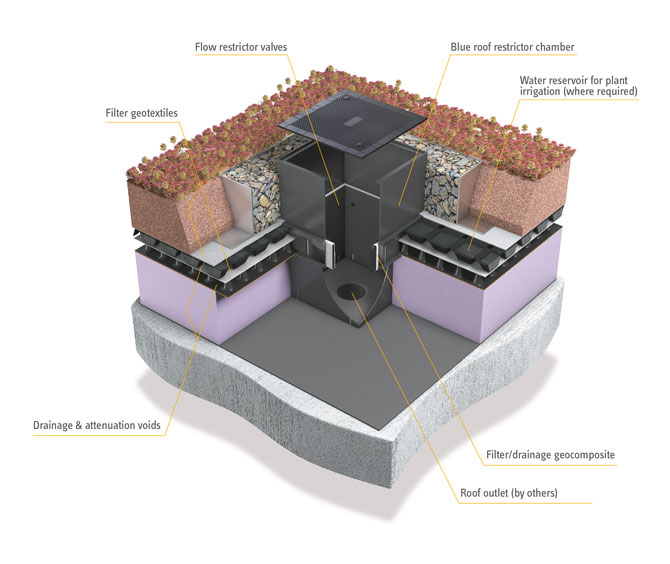
ABG blueroof restrictor chamber diagram
What is a blue roof and what are its main advantages?
RF: In the past, blue roofs were conceived as storage tanks for rainwater harvesting. Today, they form part of SuDS best practice and are designed to facilitate controlled attenuation following heavy rainfall or storms. Blue roofs are suitable for a wide range of building types from domestic to commercial. They place storm water attenuation within the building footprint, making them ideal for urban environments where ground space is limited. Blue roofs can be situated above the waterproofing membrane in a warm roof system or above the water flow-reducing layer in an inverted application, at both roof and podium levels. There is a case to be made that green roofs are a form of blue roof, because they hold water and control run-off; but green roofs cannot do this in a truly controlled way such that the attenuation capacity can be relied upon to be available for a statistically derived storm event. Specifiers may like to consider the hybrid blue/green roof, which combines the aesthetic and ecological benefits of a green roof, with the high-performance water-attenuating properties of a blue roof.
What research has been undertaken on blue roofs and what guidance is available?
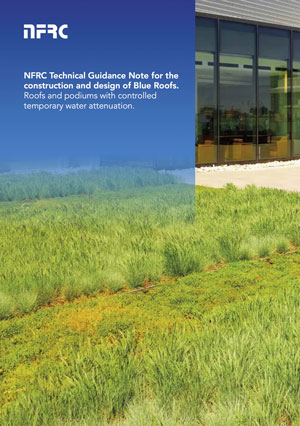
NFRC blue roof guidance
SH: ABG in association with both the University of East London and the University of Sheffield has undertaken extensive research into blue roofs, covering not only their environmental impact, but also ways of improving performance. Findings from these studies suggest that blue roofs do not adversely affect the performance and functioning of green roofs, and are suitable for a wide range of applications, including rooftop gardens, podiums and amenity areas. They have also resulted in product enhancements, such as blue roof systems that can be fully trafficked and restrictor chambers with improved flow rates.
The main source of advice is the NFRC ‘Technical Guidance Note for the construction and design of Blue Roofs’. Authored by the NFRC Joint Flat Roofing Technical Committee, of which ABG is a member, the document sets out minimum performance criteria, and includes advice on insulation, falls, waterproofing, exceedance overflows and surface finishes. More in depth guidance, including specific examples of dos and don’ts, is currently being planned by CIRIA. ABG along with other project partners is fully committed to funding and supporting this initiative. Most recently ABG has worked with the GLA on the Draft New London Plan. The document now blue roofs as a SuDS process, at the top of its SuDS drainage hierarchy.
What are the key issues in terms of specifying a blue roof?
RF: The nature and complexity of blue roofs is such that specifiers should seek a one-stop-shop approach to their design, manufacture and installation where possible. This eliminates product incompatibility and split liabilities over two of the most important components: the waterproofing layer and the blue roof system itself. It also safeguards onsite programming by ensuring that the blue roof is installed directly after the waterproofing. This avoids potential damage to the waterproof layer by follow-on trades or use of the roof as a storage place for building materials. SIG Design and Technology, in partnership with ABG, provides a comprehensive design and delivery service, including post-installation integrity tests for both the waterproofing and blue roof, as well as a guarantee for the complete system. The latter can range from 10-25 years, depending on the roof specification and maintenance schedule agreed.
SH: When approaching blue roof design, specifiers should consider the four key aspects of SuDS best practice (as set out in CIRIA’s ‘The SuDS Manual C753’): quantity, quality, amenity and biodiversity. This means careful consideration of attenuation capacity, water treatment and filtration, roof space function, and environmental/greening potential. The ability to balance these needs is the key to good SuDS practice, and will require the project team to work closely together from the outset. It is also critical to establish the roof’s future maintenance requirements as early as possible at planning stage, so that this can be fed into the design process.
In terms of material specification, always use a waterproofing layer that has a BBA Certificate for blue roofs and zero falls. ABG works only with approved suppliers, such as SIG and IKO, in order to deliver joint single-point product warranties for the whole blue roof system. Last but not least, ensure that the consultant or manufacturer responsible for the attenuation calculations carries full professional indemnity insurance.
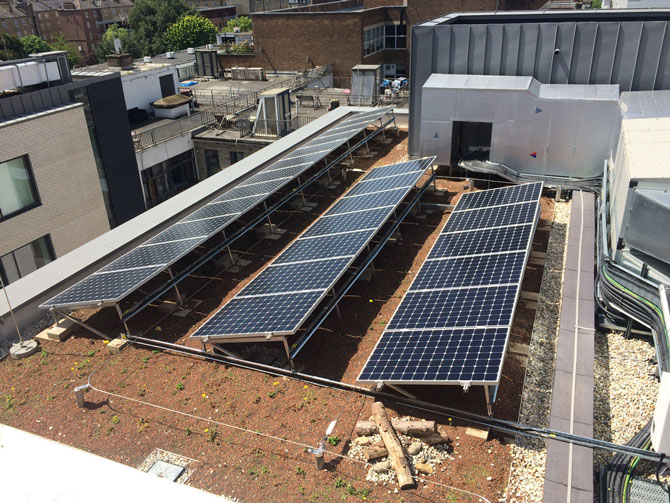
Biodiverse blue roof with photovoltaic panels (photograph: ABG)
What design and detailing issues should specifiers consider for blue roof best practice?
SH: The project’s geographical location is key, as this will give an indication of expected climate patterns and future storm events. Specifiers and clients can then decide what level of SuDS performance they need to design into the blue roof system. The next step is to establish the permitted drainage discharge rate for the site. In many cases this is limited to greenfield run-off rates, but planning authorities may set higher standards. Early consultation with a structural engineer is necessary to take account of the additional load, but this often is not a critical factor.
RF: With regards to waterproofing, SIG generally favours hot-melt bituminous systems over single-ply ones for a concrete deck as these tend to be more robust and are less likely to puncture. With the exception of emergency rainwater outlets and overflows, roof penetrations should be minimised or eliminated where possible, and each blue roof control chamber should have an integral, exceedance overflow capacity. The installation and design of the control chamber is critical, particularly with regards to the integrity of the flow rate restrictor, which may be immersed for long periods of time. The NFRC’s Technical Guidance Note for Blue Roofs advocates restrictors with an integral flange to ensure a homogenous seal.
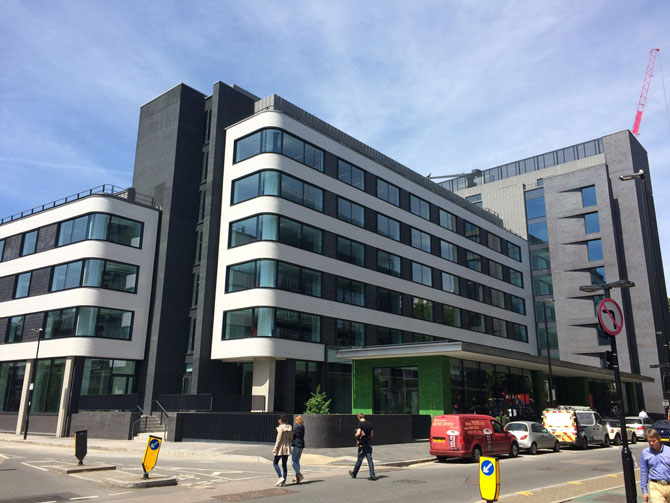
160 Old Street, London, designed by Orms (photograph: ABG)
Case Study of Blue Roof Best Practice:
Project: 160 Old Street, London
Architect: Orms
Products: IKO PermaTEC hot melt, ABG blueroof
160 Old Street is a nine-storey office redevelopment scheme in London designed by Orms on behalf of The Great Ropemaker Partnership, developed by Great Portland Estates plc. The complex 14,000-square-metre project comprises 29 different roof zones, 14 of which are blue roofs. Working with main contractor Wates as part of a design and build contract, SIG proposed an ABG blue roofsystem installed atop an inverted warm roof with an IKO PermaTEC hot-melt waterproof layer. The latter was favoured for its robustness and compatibility with the building’s concrete roof deck. ABG’s blue roof provided a cost-effective SuDS solution for a tight urban site that could not accommodate ground-based water-holding tanks.

ABG blueroof construction photos showing (left to right) geocomposite filtration and separation layer, penetration detail, geotextile wrap detail, and void formers (photos: ABG)
Designed to attenuate heavy rainfall, including one-in-100-year storm events, the blue roofs comprise an IKO PermaTEC hot melt waterproof layer on which is a layer of 180mm XPS rigid insulation. Next is ABG’s drainage/attenuation geocomposite system, and then the finished roof surface (biodiverse, paving or terrace deck). Incorporating a series of restrictor chambers, integral filter geotextiles and an integral geotextile wrap, the geocomposite layer and control chambers provides the necessary attenuation before directing rainwater to the roof rainwater outlets. Accessible from above for regular maintenance access, the restrictor chambers are key to the SuDS performance of the blue roof and site.
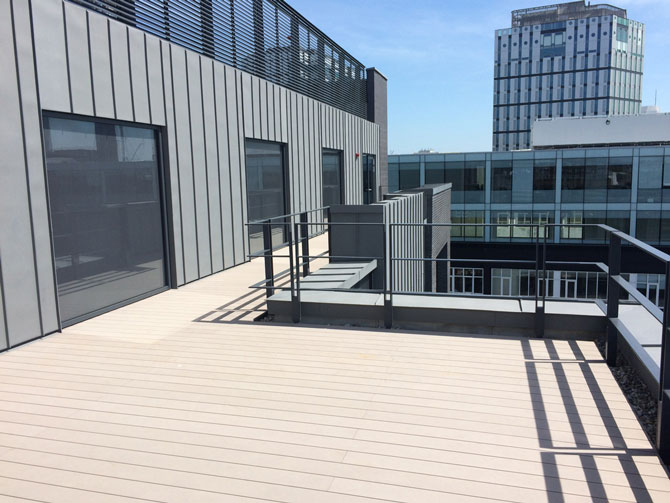
Amenity terrace blue roof (photo: ABG)
Construction was undertaken by SIG and ABG-approved installers. Regular site inspections preceded integrity tests for both the waterproofing and blue roof elements. The entire blue roof system is guaranteed by SIG.
More Information
- For more information on blue roofs visit our page on blue roofs.
- This article originally appeared in Architecture Today.




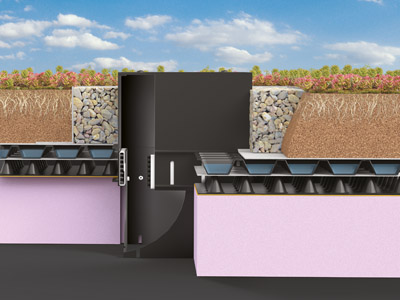
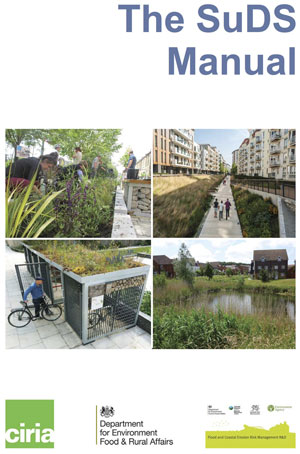
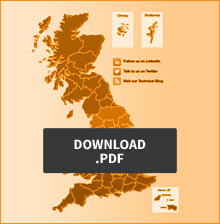








Recent Comments